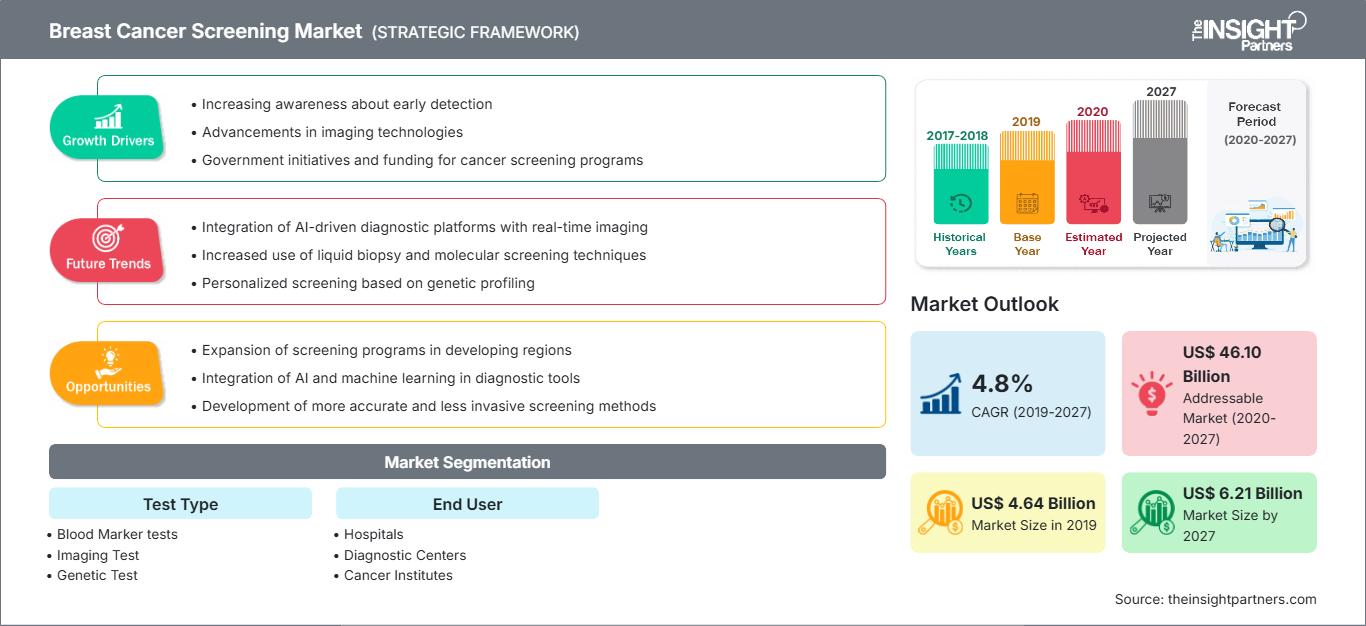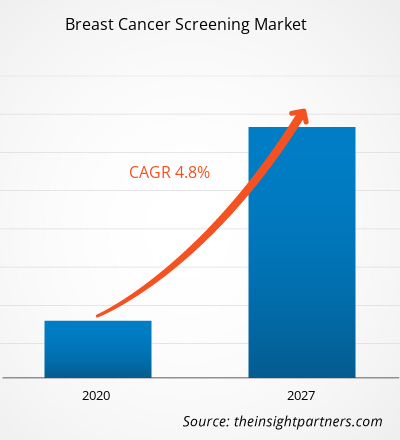[Rapporto di ricerca]Si prevede che il mercato dello screening del cancro al seno raggiungerà i 6.209,25 milioni di dollari entro il 2027, rispetto ai 4.638,63 milioni di dollari del 2019; si stima una crescita a un CAGR del 4,8% dal 2020 al 2027.
Il cancro al seno è il tipo di cancro più comune e diffuso tra le donne; si sviluppa nei tessuti mammari, solitamente nei dotti (tubi che trasportano il latte al capezzolo) e nei lobuli (ghiandole che producono il latte). Può anche insorgere nel tessuto adiposo o nel tessuto connettivo fibroso all'interno del seno. La diagnosi precoce del cancro al seno è importante in quanto può impedire che la condizione diventi critica e garantire un trattamento curabile efficace. I metodi di screening per la diagnosi del cancro al seno includono la mammografia, la risonanza magnetica per immagini (RMI), l'ecografia e altri. L'obiettivo principale dello screening è individuare la malattia nella sua fase più precoce e curabile. Le procedure di screening individuano i primi segni del cancro, prima ancora che i sintomi inizino a manifestarsi.
Personalizza questo rapporto in base alle tue esigenze
Potrai personalizzare gratuitamente qualsiasi rapporto, comprese parti di questo rapporto, o analisi a livello di paese, pacchetto dati Excel, oltre a usufruire di grandi offerte e sconti per start-up e università
Mercato dello screening del cancro al seno: Approfondimenti strategici

-
Ottieni le principali tendenze chiave del mercato di questo rapporto.Questo campione GRATUITO includerà l'analisi dei dati, che vanno dalle tendenze di mercato alle stime e alle previsioni.
Approfondimenti di mercato
Prevalenza del cancro al seno in crescita a livello globale
Il cancro al seno è tra le principali cause di morte nel mondo e influisce profondamente sulla qualità della vita. Pertanto, rappresenta un peso per la società se non diagnosticato e trattato tempestivamente. Secondo le stime dell'American Cancer Society, il cancro al seno è il tipo di cancro più comune negli Stati Uniti, poiché ha causato morbilità in circa 234.087 persone e ha portato a 41.904 decessi nel 2018. Inoltre, si prevedono circa 276.480 nuovi casi nel Paese nel 2020. Secondo il rapporto Globocan 2019, in Germania, il numero totale di casi di cancro al seno nel 2018 è stato di 71.888, e la malattia ha portato a circa 19.376 decessi in quell'anno. Inoltre, secondo il rapporto Globocan, nel 2018 si sono verificati circa 367.900 nuovi casi di cancro al seno e 97.972 decessi a causa di questo in Cina. In India, ONG, agenzie governative e organizzazioni benefiche stanno puntando sulla sensibilizzazione della popolazione sul cancro al seno per promuovere la diagnosi precoce, fornire un modulo di trattamento completo e ampliare il supporto per la gestione del tumore al seno. Tali iniziative sono il risultato della crescente prevalenza di questo tipo di tumore nel Paese. Secondo le stime del rapporto Globocan, nel 2018 l'India ha segnalato circa 162.468 nuovi casi di cancro al seno e 87.090 decessi a causa di questo. Tale crescente prevalenza del cancro al seno in diverse regioni del mondo sta aumentando la domanda globale di dispositivi di screening per lo stesso tipo di tumore.
Approfondimenti di mercato basati sulla tipologia di test
Il mercato dello screening del cancro al seno, per tipologia di prodotto, è segmentato in test dei marcatori ematici, test di imaging, test genetici e test di immunoistochimica. Il segmento dei test di imaging ha detenuto la quota di mercato maggiore nel 2019 e si prevede che registrerà il CAGR più elevato del mercato durante il periodo di previsione.
Approfondimenti basati sull'utente finale
In base all'utente finale, il mercato dello screening del cancro al seno è stato segmentato in ospedali, centri diagnostici, istituti oncologici e laboratori di ricerca. Il segmento ospedaliero ha detenuto la quota di mercato maggiore nel 2019, mentre si stima che il segmento dei centri diagnostici registrerà il CAGR più elevato del mercato durante il periodo di previsione.
Il lancio e l'approvazione dei prodotti sono una strategia comunemente adottata dalle aziende nel mercato dello screening del cancro al seno per espandere la propria presenza a livello mondiale e soddisfare la crescente domanda ampliando il proprio portafoglio prodotti. Adottano inoltre la strategia di espansione per ampliare la base clienti in tutto il mondo, il che consente loro di mantenere il proprio marchio a livello globale. Ad esempio, nel giugno 2017, Siemens Healthineers ha ricevuto l'approvazione della Food and Drug Administration (FDA) per il prodotto syngo.via VB20, che probabilmente verrà utilizzato per l'imaging molecolare (MI) di Siemens Healthineers, una nuova versione del consolidato software di visualizzazione intelligente dell'azienda per l'imaging multimodale.
Mercato dello screening del cancro al seno
Le tendenze regionali e i fattori che influenzano il mercato dello screening del cancro al seno durante il periodo di previsione sono stati ampiamente spiegati dagli analisti di The Insight Partners. Questa sezione illustra anche i segmenti e la geografia del mercato dello screening del cancro al seno in Nord America, Europa, Asia-Pacifico, Medio Oriente e Africa, America meridionale e centrale.
Ambito del rapporto di mercato sullo screening del cancro al seno
| Attributo del rapporto | Dettagli |
|---|---|
| Dimensioni del mercato in 2019 | US$ 4.64 Billion |
| Dimensioni del mercato per 2027 | US$ 6.21 Billion |
| CAGR globale (2019 - 2027) | 4.8% |
| Dati storici | 2017-2018 |
| Periodo di previsione | 2020-2027 |
| Segmenti coperti |
By Tipo di test
|
| Regioni e paesi coperti |
Nord America
|
| Leader di mercato e profili aziendali chiave |
|
Densità degli operatori del mercato dello screening del cancro al seno: comprendere il suo impatto sulle dinamiche aziendali
Il mercato dello screening del cancro al seno è in rapida crescita, trainato dalla crescente domanda da parte degli utenti finali, dovuta a fattori quali l'evoluzione delle preferenze dei consumatori, i progressi tecnologici e una maggiore consapevolezza dei benefici del prodotto. Con l'aumento della domanda, le aziende stanno ampliando la propria offerta, innovando per soddisfare le esigenze dei consumatori e sfruttando le tendenze emergenti, alimentando ulteriormente la crescita del mercato.

- Ottieni il Mercato dello screening del cancro al seno Panoramica dei principali attori chiave
Mercato dello screening del cancro al seno: per tipo di prodotto
- Test dei marcatori del sangue
- Test di imaging
- Test genetico
- Test di immunoistochimica
Mercato dello screening del cancro al seno: per applicazione
- Centri diagnostici
- Ospedali
- Laboratori di ricerca
- Istituti oncologici
Screening ...Screening del cancro al seno: per applicazione
- Centri diagnostici
- Ospedali
- Laboratori di ricerca
- Istituti oncologici
Screening del cancro al seno: per tipo di prodotto
- Test dei marcatori del sangue
- Test di imaging
- Test di imaging
Screening del cancro al seno: per tipo di prodotto
- Test dei marcatori del sangue
- Test di imaging
- Test di imaging
- Test di imaging
Screening del cancro al seno: Per area geografica
- Nord America
- Stati Uniti
- Canada
- Messico
- Europa
- Francia
- Germania
- Italia
- Regno Unito
- Spagna
- Resto d'Europa
- Asia Pacifico
- Cina
- India
- Corea del Sud
- Giappone
- Australia
- Resto dell'Asia Pacifico
- Medio Oriente e Africa
- Sudafrica
- Arabia Saudita
- Emirati Arabi Uniti
- Resto del Medio Oriente e Africa
- Sud America
- Brasile
- Argentina
- Resto del sud America
Profili aziendali
- General Electric Company
- Siemens Healthineers AG
- Exact Sciences Corporation
- Koninklijke Philips NV
- Hologic, Inc.
- BD
- Myriad Genetics, Inc.
- Oncities Corporation
- Danaher
- POC Medical Systems
- Analisi storica (2 anni), anno base, previsione (7 anni) con CAGR
- Analisi PEST e SWOT
- Valore/volume delle dimensioni del mercato - Globale, Regionale, Nazionale
- Industria e panorama competitivo
- Set di dati Excel
Report recenti
Rapporti correlati
Testimonianze
Motivo dell'acquisto
- Processo decisionale informato
- Comprensione delle dinamiche di mercato
- Analisi competitiva
- Analisi dei clienti
- Previsioni di mercato
- Mitigazione del rischio
- Pianificazione strategica
- Giustificazione degli investimenti
- Identificazione dei mercati emergenti
- Miglioramento delle strategie di marketing
- Aumento dell'efficienza operativa
- Allineamento alle tendenze normative






















 Ottieni un campione gratuito per - Mercato dello screening del cancro al seno
Ottieni un campione gratuito per - Mercato dello screening del cancro al seno